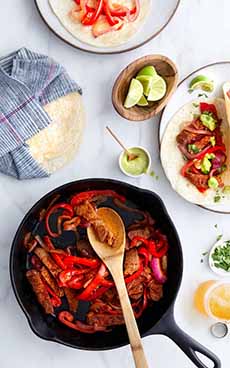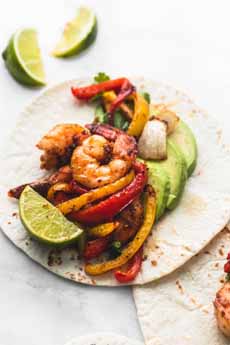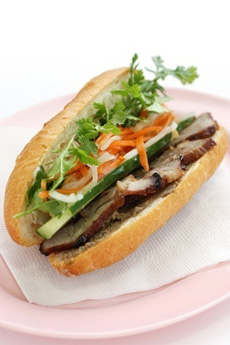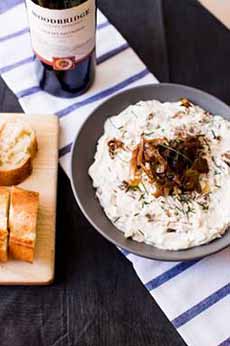|
Focaccia (foe-KAH-cha) is a thick Italian snack bread that is served with meals, used as a base for pizza and as sandwich bread. Basic focaccia is simple, sprinkled with salt; it can be topped with fresh herbs and ingredients as elaborate as any pizza. Popular toppings include sautéed onions and mushrooms, diced tomatoes, prosciutto and cheese—or they can be anything that appeals to the maker.
“Focaccia is the canvas upon which you can paint,” says chef Johnny Gnall, “and your artistic freedom should know no bounds. Sure, everyone loves some herbs or cheese on their focaccia. But if you’re interested in really expanding your palate (pun intended), try looking beyond the everyday and reach a bit further into your fridge—and your imagination.”
Check out the suggestions below as a jumping-off point, then survey your own on-hand ingredient list and get to topping! Focaccia is delicious any day of the year. If you’re a Super Bowl host, your guests will love it.
Start with a basic focaccia recipe and try the toppings below. Enjoy a batch as you watch the Super Bowl.
FOCACCIA TOPPINGS: MIX AND MATCH
When you’re making a batch of focaccia, you don’t have to limit yourself to one type of topping. Feel free to “mix and match.”
In addition to herbs and sea salt, common toppings include cherry or sundried tomatoes, cheese, olives, sautéed onions.
Fruit toppings are also popular, cherries and figs in particular.
Here are off-the-beaten-track options that are equally delicious.
APPLES & PEARS
Apples and pears, in season right now, work as focaccia toppings. Slice them very thin and lay them flat on the dough, then brush heavily with olive oil so they don’t dry out. Keep an eye on the focaccia as it bakes so that you can reapply some olive oil if the fruit gets too dry. Dust lightly with cinnamon if you’d like, but stop from heading too far in the direction of focaccia apple pie.
BEANS
Take your favorite cooked beans (canned black beans always work); toss them in olive oil and a generous amount of your favorite herbs, then sprinkle them atop the focaccia. You’ve just added protein and fiber that tastes like olive oil and herbs: a home run.
CANNED TUNA & SARDINES
Italian tuna brands are typically terrific. But as long as you use a top-grade brand, tuna is an outstanding focaccia topping. Moreover, you can use the oil it’s packed in to brush on the focaccia. The same goes for sardines or any other canned seafood. Clams and squid may seem like pushing it, but Italians will tell you otherwise. Just make sure the seafood is properly cooked and seasoned; toss it with roasted garlic to add more flavor and add some grated lemon zest.
CITRUS
No orange segments on your focaccia; instead, think of different ways to prepare citrus that would work well on soft bread with a hint of olive oil. Almost any citrus zest has a place, especially with a hearty green like kale or chard. Julienned pieces of preserved lemon rind are delicious, their intense flavor and saltiness softened with some crumbled goat cheese. For an even greater wow factor, top your focaccia generously with rosemary and paper-thin slices of grilled lemon or blood orange.
CUSTOM SAUCES
Create your own sauces for focaccia. An easy one is sour cream mixed with mustard and seasoned with salt and pepper. It’s a great way to add moisture to the focaccia and it goes well with almost any vegetable. Another option: Mix roasted garlic with olive oil or a bit of chicken stock to make a spreadable paste. If you’re stuck for ideas, grab an armful of jars out of the fridge and just start mixing!
DRIED FRUIT
Chop dried apricots and dried cherries, toss them in olive oil and sprinkle them over the focaccia, followed by a very light dusting of cinnamon. The key here is knowing that less is more; too much fruit or cinnamon will taste like a failed attempt at dessert. With just a bit of both, you still get a light olive oil flavor from the bread. It also works as breakfast focaccia.
NORI
Seaweed on pizza? Paired with the right ingredients, it works: Nori has umami, which pretty much makes anything better. Try a focaccia with anchovy filets, thin strips of nori, sesame seeds, chile flakes, and sea salt. You won’t find focaccia in Tokyo; but if you did, this is probably what it would be like.
PICKLED PEPPERS
Be they jalapeños, banana peppers, pepperoncini or another favorite, pickled peppers can bring a lot to an otherwise one-dimensional focaccia. They add brightness and acidity, both of which balance richer toppings. For a killer tag team, try focaccia with pickled peppers and shredded bacon or turkey bacon.
PINE NUTS
Not many nuts work on focaccia, but pine nuts—an Italian favorite—do. They get incredibly buttery when roasted and they also go well with fresh herbs. If you put basil, pine nuts, and a little Parmesan cheese on focaccia, you basically have a deconstructed pesto. Add some grated lemon zest for a final flourish.
SEASONAL VEGETABLES
Try butternut or your favorite squash: Peel it, cut it into a very small dice, coat generously with olive oil, and season with salt and pepper. Then sprinkle it onto the focaccia along with your favorite herbs (rosemary works great) and bake. Hearty winter greens (kale, chard, spinach, and even Brussels sprout leaves) are also ideal focaccia toppings; their edges get crispy in the oven and add a pleasant dimension of texture.
Check out the different types of bread in our Bread Glossary.
> THE HISTORY OF FOCACCIA
> THE HISTORY OF BREAD
|
|
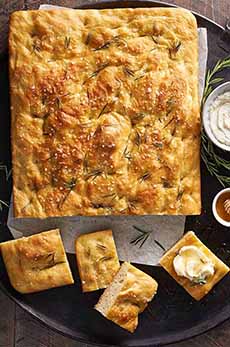
[1] Basic focaccia can be completely plain, or topped with rosemary and sea salt (photo © King Arthur Flour).
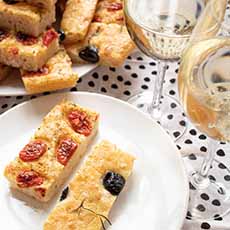
[2] Popular toppings include cherry tomatoes, Kalamata olives, and sauteed onions (photo © Paula Berto | Unsplash).
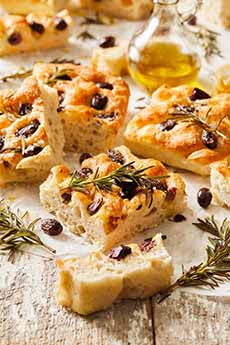
[3] Kalamata olive with rosemary is a popular combination. Here’s the recipe (photo © DeLallo).

[4] Add artichoke hearts for more sophistication (photo © Maman Restaurant | NYC).
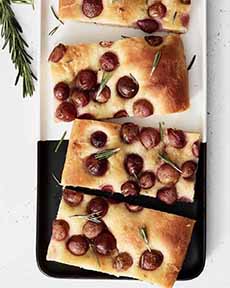
[5] Grape focaccia. Here’s the recipe (photo © King Arthur Flour).

[6] Blueberry focaccia. Here’s the recipe (photo © DeLallo).
|

